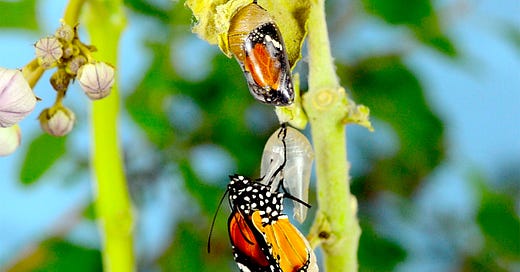Greetings Friends. How is your heart? In the face of so much violent cruelty and overwhelming collective trauma, I sometimes struggle just to find my breath. When I do, I look to Nature for the wisdom needed to navigate these times.
What is it that allows us to go a new way—whether in our personal lives or in the collective life of a city, a nation, or the world? There is an apt metaphor in the lifecycle of the caterpillar and its metamorphosis into a butterfly.
In the mid-1990s, when I was living in Durham, NC, the local Life and Science Museum hosted a special outdoor exhibit on butterflies. The designated area had been turned into a natural habitat incubator with literally hundreds of chrysalises of varied sizes, shapes, and colors hanging like ornaments from the tree branches. They were so plentiful that if you stood in any one place for just a short while you were certain to witness the process of emergence.
Again and again the arduous birthing was repeated, with these shriveled wet creatures fighting their way free of a self-woven womb that had become their imprisonment. It was like the Nature Channel live, up-close-and-personal. The newly developed beings bore little resemblance to butterflies—they had bloated wet bodies and little stubby wings. But as they pumped the fluid from their swollen bodies into their extending wings, a second metamorphosis took place: one in which they claimed their new form in all its power and beauty. And then they flew. The whole process was some serious hard work. Yet without that struggle, their wings would never gain the size and strength necessary to support their new existence.
Caterpillars are eating machines. (If you’re a gardener, you probably know this.) They can consume hundreds of times their own weight in a single day, defoliating many plants in the process, before eventually entering into chrysalis. Inside the chrysalis, the caterpillar body breaks down. The same enzymes that enabled their destructive consumption now digest them from within, forming a kind of protoplasmic stew. In that stew are what biologists have poetically named “imaginal cells.”
It’s these cells that carry the pattern for butterfly. At first they are destroyed by the immune system as “other” to the self-ness of caterpillar. But as more of them emerge, and especially as they begin to link together, the “self” is redefined—transmuted completely. Imaginal cells are present in the skin of the caterpillar its entire life, but remain dormant until the crisis of breakdown allows them to develop, gradually replacing the caterpillar pattern with the one for butterfly.
As we experience the massive social and ecological violence unleashed in today’s world, I take courage from the parable of the caterpillar, and how its own excesses of consumption ultimately lead to its dissolution and transformation.
Perhaps our destructive over-consuming society is poised for a collective metamorphosis and each of us is an imaginal cell, holding the blueprint for a new way of being. Perhaps as we come together in the vision of possibility, a momentum is generated, redefining our selves and our world. What looks (and no doubt feels) like the worst conceivable outcome for the caterpillar is actually the threshold for an expanded realm of existence: the birth of liberation and flight.
It’s because of the breakdown (in the caterpillar and in the world) that imaginal cells are activated and catalyze metamorphosis. We can’t just build a new world on the infrastructure of the old one. In metamorphosis the caterpillar doesn’t simply sprout wings and become a flying caterpillar—it dissolves into formless goo. And from that goo, something entirely new emerges, no longer recognizable as what it was before. The alchemy happens in the liminal space of the in-between.
As the devastation and chaos of the times we are in force the collapse of familiar social structures, we have the opportunity for collective metamorphosis. Some folks are still trying desperately to resurrect the caterpillar, or to pin wings on it, but we can’t tinker our way out of a system that was conceived in domination and has genocide at its root. A total dissolution and transmutation is required.
The great activist and philosopher Grace Lee Boggs suggested we see every crisis as not only a danger, but also an opportunity to become more creative, “to become the new kind of people that are needed at such a huge period of transition.”
Whatever we may face in the days and years ahead will require the solidarity and creativity of imaginal cells, and the willingness to be transformed.
**
This post is adapted from my forthcoming book, Soul Medicine for a Fractured World: Healing, Justice, and the Path of Wholeness (Orbis Books, Dec. 2025).
Photo by Bankim Desai on UnSplash.





Thank you for your wise words and insights at a time like this... and always.
Oh, Liza, thank you from the bottom of my heart for this beautiful and life-giving perspective on these difficult times. You have given me new hope and new language — “imaginal cells”! What a blessing you are to all of us, Wise One!